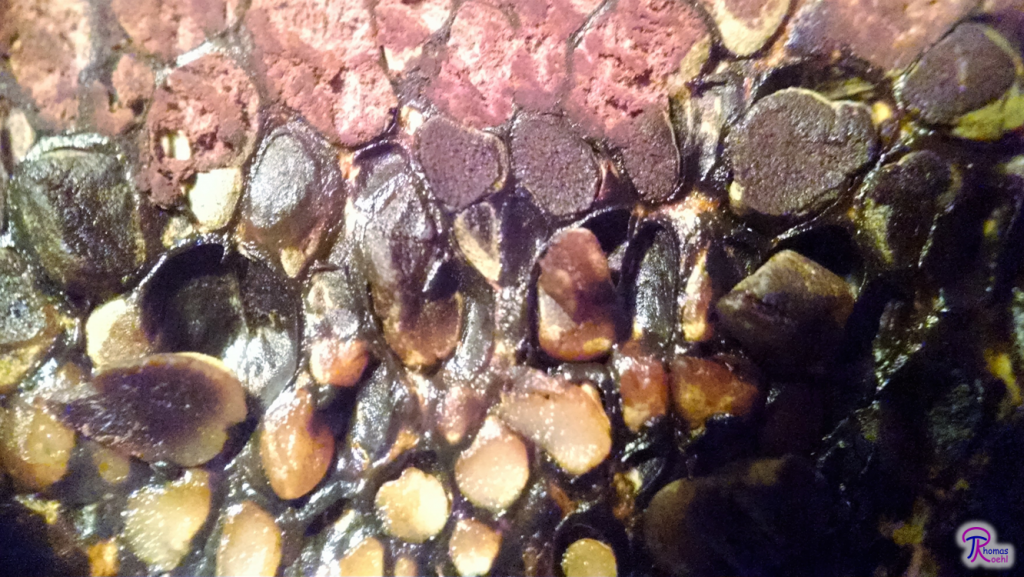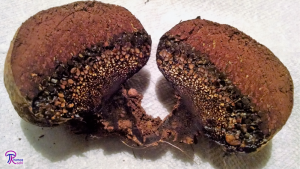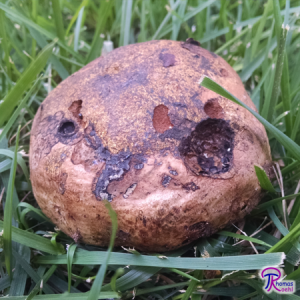#119: Pisolithus arrhizus, the Dyeball

Close-up of the interior of Pisolithus arrhizus. The Dyeball is an unusual earthball because its gleba is composed of small peridioles. The young peridioles are white and move up the mushroom as they mature. Old peridioles at the top are full of mature spores.
“Our next contestant in the Ugly Mushroom Contest performs countless of hours of community service every year and is an accomplished artist. Its goal in life is to make the world a better place and form lasting relationships with those around it. Give it up for…Pisolithus arrhizus! [applause]” There seems to be little doubt among mushroom hunters that P. arrhizus is one of the ugliest mushrooms in the world. The fruiting bodies of older specimens become distorted and can be mistaken for anything from animal feces to decomposing tree stumps. Despite its unsightly appearance, this earthball is used to dye wool, thus earning it the common name, “Dyeball.” The fungus is also prized by foresters for its ability to form robust mycorrhizas in extremely poor soil conditions.1–4
Description
Young Dyeballs look a lot like most other earthballs (and most rocks); they are roughly spherical with a smooth surface dominated by white, yellow, purple, or brown shades. Despite this fact, you can easily identify the mushroom once you pick it up. If you dig up the entire mushroom, you will find it has a stocky root-like base that projects into the ground. The base usually has yellow mycelial threads attached.1–3 This combination of a rooting base with yellow mycelium is quite distinctive. Even more distinctive, though, is its messiness. While picking up the mushroom, you probably squeezed it a little. If you did and the mushroom is young and fresh, it’s likely that your fingers are now covered in a sticky tar-like goo. P. arrhizus has a very thin outer skin (which is unusual for earthballs), so its blackish gelatinous filling oozes out when squeezed. This characteristic is unique to Pisolithus, allowing you to quickly figure out the species after you pick it up.

The Dyeball is easily identified by its unique gleba, which features small peridioles embedded in black goo. Also note the root-like base, which is usually covered in yellow mycelium (not visible).
You could stop there, but the most distinctive feature of this mushroom is its interior. When sliced in half (top to bottom), the Dyeball displays a beautiful mosaic pattern in its gleba. At the very bottom, the sterile, root-like base is dark brown to black. Just above that, you can see tiny, whitish to yellowish dots called “peridioles” that stand out against their dark surroundings. The peridioles rest in a cushion of black tar-like material that you can see oozing out all the way to the base. As you move up the mushroom, the peridioles get larger and become roughly pea-sized. The space between the peridioles decreases as they get larger, squashing them into an irregular tessellating pattern. About halfway up the fruiting body (or higher/lower if the mushroom is younger/older), the peridioles start turning black or olive-brown. Each peridiole is a bundle of spore-producing tissue, so the color change indicates the point at which spores begin to form. At the top of the mushroom, the mature spores in the peridioles become cinnamon-brown and powdery. Here, the walls between the peridioles start to break down, leaving an undifferentiated mass of powdery, brown spores at the very top of the earthball.1–3
Once enough mature spores build up, the skin on the top of the mushroom cracks open to reveal the powdery mess. The Dyeball can still produce more spores once this happens because peridioles mature from the top down. At this stage, mushroom growth becomes somewhat erratic, causing the Dyeball to look less and less like a ball. Mature P. arrhizus mushrooms grow up to 20cm across and 5-30cm tall or taller and often end up in strange shapes, such as that of a pile of dung, a tree stump, a top, an enormous molar, etc. This mushroom’s odor becomes fouler as it matures, but starts out as mild to fragrant.1–3
Ecology
P. arrhizus is found all across the globe in at least 33 different countries. It is widespread in North America, though most commonly encountered in the southeastern and pacific coast regions. The mushrooms appear in the summer and fall, but P. arrhizus may also fruit during the winter in warmer climates. This mushroom often grows in places you would expect mycorrhizal fungi to avoid: sandy soil, gravel, runoff ditches, lawns, and other areas of low soil quality. Mushrooms of P. arrhizus have even been known to push through asphalt!1–3

Pisolithus arrhizus can grow just about anywhere. This one was growing in the thin strip of grass between the sidewalk and the road and was probably associated with a nearby oak tree.
One of the most significant aspects of P. arrhizus is its exceptional ability to form ectomycorrhizas. The Dyeball is one of the most generous mycorrhizal partners, so foresters and others often inoculate tree seedlings with P. arrhizus spores to give the plants an early growth boost. There are many other mushrooms that can be used for the same purpose, but P. arrhizus the easiest because it forms mycorrhizas with a wide variety of tree species.1,2,4,5 The fungus is known to partner with over 40 species of trees, including various species of pine, birch, oak, Douglas-Fir, hemlock, willow, and poplar.6 The Dyeball is also useful in reclamation and reforestation efforts because it can grow in very poor soils with high acidity, heavy metal concentration, temperatures, and likelihood of drought.4,5
Although P. arrhizus does not associate with eucalyptus, there are other species of Pisolithus that do. If you find a mushroom under eucalyptus matching the above description, it’s probably some species of Pisolitus that was imported from Australia.5
Edibility and Uses
We’re talking about one of the world’s ugliest mushrooms and you want to eat it? Apparently, some people do eat P. arrhizus when very young, but this is not recommended.3 Most earthballs are poisonous, so it is likely that P. arrhizus does have some toxins. Additionally, avoiding the group entirely ensures you don’t eat a misidentified earthball.
The Dyeball, as its common name implies, can also be used for dyeing wool. P. arrhizus is counted among the best mushrooms for dyeing and imparts wool with a deep brown to reddish-brown to blackish color. The pigments come from the tar-like gel between the peridioles, so younger Dyeballs work better.4,7
Taxonomy and Nomenclature
P. arrhizus is placed in the family Sclerodermataceae, along with the other earthballs. Its closest relative outside its genus is Astraeus hygrometricus, another bizarre earthball (see FFF#042). All the earthballs belong to the Boletales, which also includes the boletes (umbrella-shaped mushrooms with pores underneath the cap). This relationship may explain the unusual peridioles in P. arrhizus. Earthballs are thought to have evolved from boletes by not opening up fully. The advantage to this is that a fully closed exterior protects against water loss.4,5 If this is true, then the preidioles may be evolutionary remnants of bolete pores!
Finally, a couple of notes on the names. P. arrhizus is also called P. arhizus or P. tinctorius. All three names are used by various websites and field guides, so don’t be surprised when you come across the other names.1,5 I used P. arrhizus in this post because Mycobank listed that as the current name.8 “Piso-” means “pea” and “lith” means stone, so the genus name, Pisolithus, means “pea-stone.” This alludes to the mushroom’s unique gleba. The name “arrhizus” means “having no roots” and does not describe any obvious part of the mushroom.2,5 I like the name “tinctorius” better because it refers to the earthball’s use in yarn dyeing. If you ask me, “wool-dyeing pea-stone” is a better description of the mushroom than “rootless pea-stone,” but I really don’t have any say in the matter. Given the wide host and geographic ranges of this mushroom, it is likely that the current definition includes multiple species.5 If further studies demonstrate that this is the case, then the problem could change from “What is the right name for this mushroom?” to “What are the right names for these ten mushrooms?”
To add to the naming confusion, P. arrhizus also has multiple common names. In North America, the most common name is “Dyemaker’s Puffball.” Unfortunately, it is actually placed in the “False Puffball” or “Earthball” morphological group, so the correct names to use would be “Dyemaker’s False Puffball” and “Dyemakers Earthball.” These names haven’t quite caught on, but “Dyeball” is a popular alternative. That name is short and frequently used, which is why I chose it for this post. A number of other common names describe the earthball’s unsightly appearance, including: “Dead Man’s Foot,” “Dead Man’s Fist,” and many variations on “Dog Turd Fungus” (that last one is thanks to Tom Volk).2,4,5
| Kingdom | Fungi |
| Division (Phylum) | Basidiomycota |
| Subdivision (Subphylum) | Agaricomycotina |
| Class | Agaricomycetes |
| Subclass | Agaricomycetidae |
| Order | Boletales |
| Family | Sclerodermataceae |
| Genus | Pisolithus |
| Species | Pisolithus arrhizus (Scop.) Rauschert (1959)8 |
This post does not contain enough information to positively identify any mushroom. When collecting for the table, always use a local field guide to identify your mushrooms down to species. If you need a quality, free field guide to North American mushrooms, I recommend Michael Kuo’s MushroomExpert.com. Remember: when in doubt, throw it out!
See Further:
http://botit.botany.wisc.edu/toms_fungi/jun2003.html
http://www.mushroomexpert.com/pisolithus_tinctorius.html
http://www.mykoweb.com/CAF/species/Pisolithus_arhizus.html
Citations
- Kuo, M. Pisolithus tinctorius. MushroomExpert.Com (2006). Available at: http://www.mushroomexpert.com/pisolithus_tinctorius.html. (Accessed: 11th August 2017)
- O’Reilly, P. Pisolithus arrhizus (Scop.) Rauschert – Dyeball. First Nature Available at: http://www.first-nature.com/fungi/pisolithus-arrhizus.php. (Accessed: 11th August 2017)
- Wood, M. & Stevens, F. California Fungi—Pisolithus arhizus. The Fungi of California Available at: http://www.mykoweb.com/CAF/species/Pisolithus_arhizus.html. (Accessed: 11th August 2017)
- Volk, T. J. Pisolithus tinctorius, the dog turd fungus,. Tom Volk’s Fungus of the Month for June 2003, also known in more polite compay as the dyemaker’s puffball. Tom Volk’s Fungi (2003). Available at: http://botit.botany.wisc.edu/toms_fungi/jun2003.html. (Accessed: 11th August 2017)
- Vellings, E. C. Dead Man’s Foot. MykoWeb (2006). Available at: http://www.mykoweb.com/articles/DeadMansFoot.html. (Accessed: 11th August 2017)
- Marx, D. H. Tree host range and world distribution of the extomycorrhizal fungus Pisolithus tinctorius. Can. J. Microbiol. 23, 217–223 (1977).
- Bessette, A. & Bessette, A. Mushrooms to Dye For. North American Mycological Association (2015). Available at: http://www.namyco.org/mushrooms_to_dye_for.php. (Accessed: 11th August 2017)
- Pisolithus arrhizus. Mycobank Available at: http://www.mycobank.org/BioloMICS.aspx?TableKey=14682616000000067&Rec=41945&Fields=All. (Accessed: 11th August 2017)







![#011: Characteristics of Kingdom Fungi [Archived]](https://www.fungusfactfriday.com/wp-content/themes/hueman/assets/front/img/thumb-small-empty.png)
